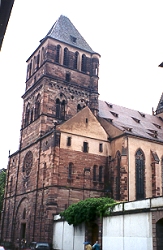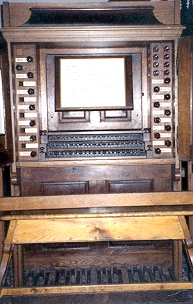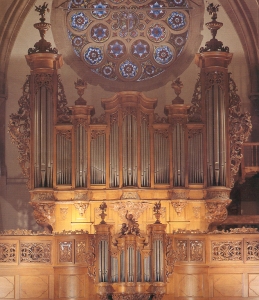

Strasbourg
|
| The Silbermann organ | Original Stoplist | Present Stoplist |
| Top of Page | The Silbermann organ | Original Stoplist | Present Stoplist |
| Grand Orgue C-c''' | Rückpositif C-c''' | Echo c'-c''' | Pédale C-c' | ||||||||||||||||||||||||||||||||||||||||||||||||||||||||||||||||||||||||||||||||||||||||||||||||||||||||||||||||||||
|---|---|---|---|---|---|---|---|---|---|---|---|---|---|---|---|---|---|---|---|---|---|---|---|---|---|---|---|---|---|---|---|---|---|---|---|---|---|---|---|---|---|---|---|---|---|---|---|---|---|---|---|---|---|---|---|---|---|---|---|---|---|---|---|---|---|---|---|---|---|---|---|---|---|---|---|---|---|---|---|---|---|---|---|---|---|---|---|---|---|---|---|---|---|---|---|---|---|---|---|---|---|---|---|---|---|---|---|---|---|---|---|---|---|---|---|---|---|---|---|
| Bourdon | 16 | Bourdon | 8 | Bourdon | 8 | Soubasse | 16 | ||||||||||||||||||||||||||||||||||||||||||||||||||||||||||||||||||||||||||||||||||||||||||||||||||||||||||||||||
| Montre | 8 | Prestant | 4 | Prestant | 4 | Octavebass | 8 | ||||||||||||||||||||||||||||||||||||||||||||||||||||||||||||||||||||||||||||||||||||||||||||||||||||||||||||||||
| Bourdon | 8 | Flûte | 4 | Cornet III | Quinte | 5 1/3
| Prestant | 4 |
| Nazard | 2 2/3 |
| | |
| Prestant | 4
| Nazard | 2 2/3 |
| Doublette | |
| | |
| Bombarde | 16
| Doublette | 2 |
| Tierce | 1 3/5 |
| | |
| Trompette | 8
| Tierce | 1 3/5 |
| Fourniture | |
| | |
| Clairon | 4
| Cornet V | |
| Cromorne | 8 |
|
| Fourniture IV | |
| | |
| Cymbale III | |
| | |
| Trompette | 8
| Voix humaine | 8
| Clairon | 4
|
|
Couplers: Rückpositiv to Grand Orgue, Grand Orgue to Pédale
| Tremblant | ||||||||||||||||||||||||||||||||||||||||||
|
In spite of this essentially French stoplist, the sound of the organ sets it apart from the usual "Parisian" French Classical organ.169
|
| Top of Page | The Silbermann organ | Original Stoplist | Present Stoplist |
| Grand Orgue C-c''' | Rückpositif C-c''' | Echo C-c''' | Pédale C-d' | ||||||||||||||||||||||||||||||||||||||||||||||||||||||||||||||||||||||||||||||||||||||||||||||||||||||||||||||||||||||||||||||
|---|---|---|---|---|---|---|---|---|---|---|---|---|---|---|---|---|---|---|---|---|---|---|---|---|---|---|---|---|---|---|---|---|---|---|---|---|---|---|---|---|---|---|---|---|---|---|---|---|---|---|---|---|---|---|---|---|---|---|---|---|---|---|---|---|---|---|---|---|---|---|---|---|---|---|---|---|---|---|---|---|---|---|---|---|---|---|---|---|---|---|---|---|---|---|---|---|---|---|---|---|---|---|---|---|---|---|---|---|---|---|---|---|---|---|---|---|---|---|---|---|---|---|---|---|---|---|---|---|---|
| Bourdon | 16 | Bourdon | 8 | Bourdon | 8 | Soubasse | 16 | ||||||||||||||||||||||||||||||||||||||||||||||||||||||||||||||||||||||||||||||||||||||||||||||||||||||||||||||||||||||||||
| Montre | 8 | Prestant | 4 | Salicional | 8 | Octavebass | 8 | ||||||||||||||||||||||||||||||||||||||||||||||||||||||||||||||||||||||||||||||||||||||||||||||||||||||||||||||||||||||||||
| Bourdon | 8 | Flûte | 4 | Prestant | 4 | Quinte | 5 1/3
| Prestant | | 4 |
| Nazard | | 2 2/3 |
| Flûte | | 4 |
| Prestant | | 4
| Nazard | | 2 2/3 |
| Doublette | | |
| Doublette | | 2 |
| Bombarde | | 16
| Doublette | | 2 |
| Tierce | | 1 3/5 |
| Larigot | | 1 1/3 |
| Trompette | | 8
| Tierce | | 1 3/5 |
| Fourniture | | |
| Flageolet | | 1 |
| Clairon | | 4
| Cornet V | | |
| Cromorne | | 8 |
| Cornet
| Fourniture IV | | |
| | | |
| Cymbale | |
| Cymbale III | | |
| | | |
| Trompette | | 8
| Trompette | | 8
| Voix humaine | | 8
| Clairon | | 4
|
|
Couplers: Rückpositiv to Grand Orgue, Echo to Grand Orgue,
| Grand Orgue to Pédale, Echo to Pédale Separate Tremulants for Grand Orgue and Rückpositiv, and Echo | ||||||||||||||||||||
| Top of Page | The Silbermann organ | Original Stoplist | Present Stoplist |
© 2000 AD James H. Cook
 Although much of the
interior of St. Thomas contains items of the type you might expect to find in any church, there is one feature here that is unique: The
original keydesk of the 1741 Silbermann organ has been installed in a free-standing exhibit at the west end of the nave. The manual
keyboards and the black stop knobs are original, while the pedalboard and stop knobs in the upper right-hand group date from the end of
the eighteenth century and later. One of the treasures of the church, the organ was played by Mozart in 1778, and a copy of a letter
from Mozart to his father, in which he describes his experiences in Strasbourg, is framed on one of the doors of the console.
Although much of the
interior of St. Thomas contains items of the type you might expect to find in any church, there is one feature here that is unique: The
original keydesk of the 1741 Silbermann organ has been installed in a free-standing exhibit at the west end of the nave. The manual
keyboards and the black stop knobs are original, while the pedalboard and stop knobs in the upper right-hand group date from the end of
the eighteenth century and later. One of the treasures of the church, the organ was played by Mozart in 1778, and a copy of a letter
from Mozart to his father, in which he describes his experiences in Strasbourg, is framed on one of the doors of the console.
 The organ was built in 1741 by
Johann Andreas Silbermann, son of Andreas Silbermann, both of whom were noted organ builders in Alsace. In many ways the organs of
Johann Andreas Silbermann contain elements of both French and German organ-building of the eighteenth century. For example, the case
has many characteristics one expects in French Classical Organs:
The organ was built in 1741 by
Johann Andreas Silbermann, son of Andreas Silbermann, both of whom were noted organ builders in Alsace. In many ways the organs of
Johann Andreas Silbermann contain elements of both French and German organ-building of the eighteenth century. For example, the case
has many characteristics one expects in French Classical Organs: